Several years ago, when GAME OF THRONES was still a popular TV show, I saw an article about an interview with the costume designer Michele Clapton that really changed the way I looked at fashion in storytelling. I was already familiar with the concept of fashion as a form of communicating economic or religious status (expensive handbags or religious clothing), and most people are familiar with the idea of national costumes, but Michele introduced me to the idea of fashion as part of storytelling.
As I started to apply this in my own writing, I also started noticing it in visual media such as shows. I’ve found that it’s a very good way to present it to authors because it’s easy to see, visualize, and conceptualize within individual worlds. If you can turn fashion and colors into part of the worldbuilding it adds another layer of storytelling that you can use for communication, foreshadowing, and general cleverness.
One of the first shows that I really noticed this was the Mandarin-language show THE ROMANCE OF TIGER AND ROSE. 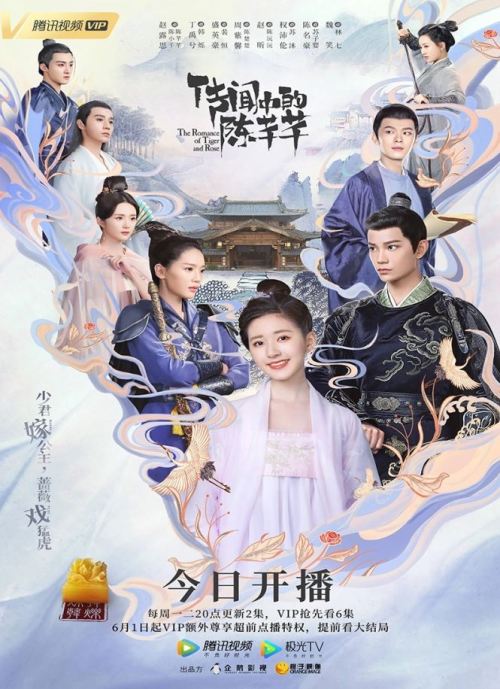
Title: THE ROMANCE OF TIGER AND ROSE
Country: China
Genre: RomCom
Basic Premise: Scrappy script writer Chen Xiao Qian (XQ) (played by Zhao Lu Si) wants to get *paid* (like every writer does) but the production company won’t pay her until the lead actor, Han Ming Xing (played by Ryan Ding), signs off on the script. XQ goes in Ming Xing to discuss the role of Han Shuo (HS), the man XQ envisions as a noble warrior hero who falls in love with the virtuous heroine, Chu Chu (CC), simply because she is noble, beautiful, and kind.
Ming Xing rejects this and pictures a more ruthless HS, one willing to lie and betray people to conquer the neighboring city.
XQ goes home to rewrite the script, gets sicks, and falls into her script… is it a dream? Is she really there? Can she die? No one knows! And now the fun begins…
Spoilers below the cut so proceed with caution. 🙂
It took me several episodes to realize there was a color code for this show, which shows the depth and thought the show runners put into this. Most costume departments with shows on tight budgets don’t put a ton of thought into their productions, but someone in the design room really is a genius and deserves appreciation and awards.
The original poster for the drama and the opening scenes give us the primary color code: White – Red – Black – Blue
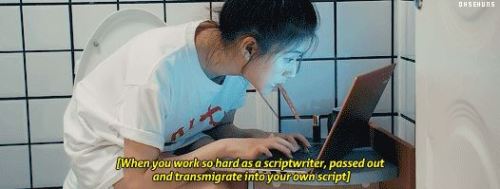
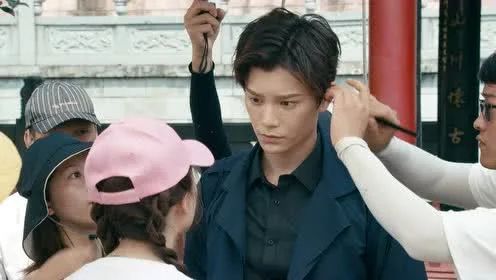
In the first episode Xiao Qian/Qian Qian(the script writer – CQQ) is wearing her go to colors of White and Red (or pink).
Throughout the drama Red is CQQ’s bold color, it’s what she wears when she’s being free spirited in the modern world and selfish in the script world. When she’s writing we see she’s mostly wearing white, it’s her passive, intimated color in the modern world, but she has a bit of red at her heart.
When CQQ confronts Han Ming Xing, the actor and modern world equivalent of Han Shuo, she’s wearing a pink hat. It’s a nod to her internal Red feelings, but muted. She really believes in this script, she wants something, and she’s trying to be brave but can’t be her full Red self.
We also see Han Shuo in full opposition mode wearing his signature Black. Throughout the drama HS’s colors tell the viewer whose side he’s on.
HS in White => Loyal to CQQ or following the script
HS in Black => Fighting CQQ
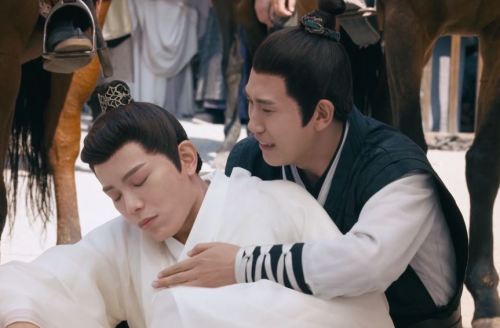
When HS arrives and is kidnapped by Third Princess (not yet the scriptwriter but purely the wild character that Xiao Qian wrote) he is wearing his submissive/following-the-script White and 3rd Princess is in her wild Red.

This is important for the ending.
The the modern/real world Red is the scriptwriters brave color, it’s a sign she’s passionate about something. In the script world is usually means she’s causing trouble.
The colors of the OTP clash in the opening. She is wild and reckless, he is submissive and weak (or at least pretending to be). He is the captured tiger, she is the wild rose full of thorns.
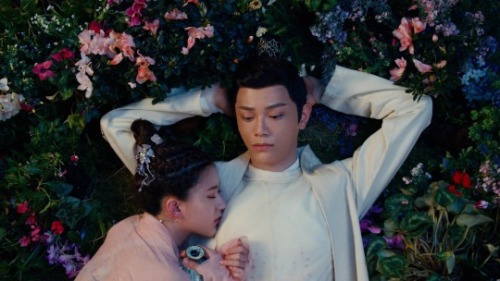
As their relationship progresses CQQ’s colors become more mute, less of the wild Red and more of the softer, balanced pink that shows both her real personality and the wild red personality she secretly wants to enjoy.
HS’s clothes stay in the pure submissive white until he makes choices that align him with CQQ.
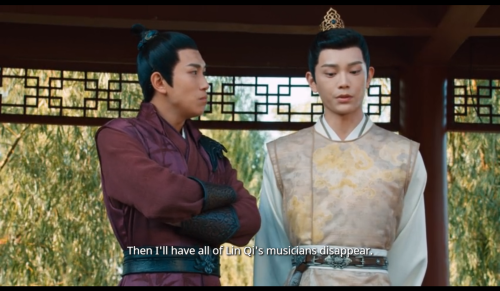
As HS opens up we see him adding color to his White costumes and nods to his allegiances. We also see the introduction of the black line on his clothes. Either a black belt or a collar decoration which is what HS wears when he is feeling like himself. He isn’t all good or all evil, he’s not neutral. He’s a tiger, gentle with those he cares for and ferocious to everyone else. Around CQQ he can be very tender, but he retains his ability to be dangerous, decisive, and lethal when he wants to be.
Here we also see Bai Ji, HS’s right hand man, who here is wearing CQQ’s fighting colors. BJ will never fully align with CQQ. He doesn’t like her, he doesn’t support her, and for the first half of the drama he is actively working against her BUT he’s working for the original plot the script writer wrote so he’s wearing pro-script Red.
BJ is also in the arrival scene wearing White and Black as he balances out the narrative of a prince held hostage being sold off into an arranged marriage.

Later we see HS in the same costume almost perfectly matched to CQQ. They are alone in a sea of dark colors.
In the script world CQQ wears pastels whenever she’s just trying to keep up. They aren’t her signature color, but it does signify trying to put herself in the background as an observer. When she and HS are working together they’ll wear similar or complimenting colors.
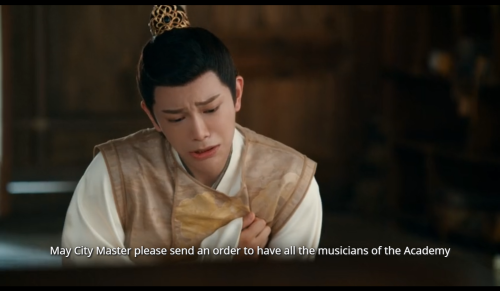
When HS goes to beg the City Master for life of the musician CQQ wants to protect you can see the line of the black collar is almost completely hidden for the scene. The costume does an excellent job of showing us that HS is hiding his true feelings and true thoughts.
If there’s any doubts in the viewers mind there’s a little smirk and a lick at the end as the happy tiger walks away with what he wants.

As the plot goes on, and the script writer feels like she’s losing control of the story, we see the other major color – Blue – come into play.
Blue is the signature color of the city where women rule, it’s worn by most the major characters at some point, and always by CQQ’s enemies.

Chuchu, the 2nd Princess and leader of the city’s guard wears Black and Blue as she descends into war with her sister for the spotlight. Tingting, the instigator, always wears Blue or Black.

Pei Heng, the Minister of Education, wears Blue almost all the time, a nod to both his role in the city and his role as antagonist. CQQ loves him as a character, he was the favorite person she wrote, but she doesn’t have romantic feelings for him and his attraction to her and desire to win her over often interferes with CQQ’s goals. Despite believing he is on her side Pei Heng is almost always CQQ’s enemy.
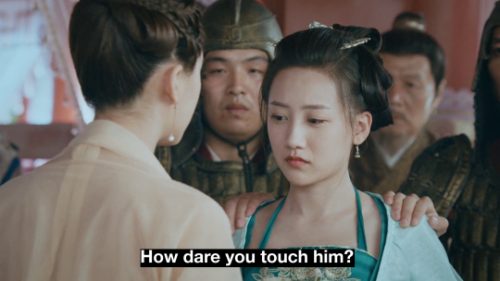
Lin Qi, CQQ’s rival, is always in Blue or green (her signature color). The exception is when Lin Qi goes into exile and wears Black. I’m writing this without having seen the last six episodes, but I’m willing to bet that when (or if) she comes back she won’t be wearing Blue.

When CQQ is pushing for the original script (2nd Princess falls in love with HS and takes the city while CQQ dies) she’s wears Red and Black.

This is a really good GIF that shows the color theory for the show… Tingting is in Blue, clearly an enemy. CQQ has her White under layer which is her true self, or the self that’s closest to the heart, but over it she’s wearing her wild Red and the Black of war… but the costume is broken. There’s strips of color and distinct layers that mimic CQQ’s conflict over her choices. Meanwhile, HS is wearing all White. He’s not being true to himself but he is being loyal to CQQ.
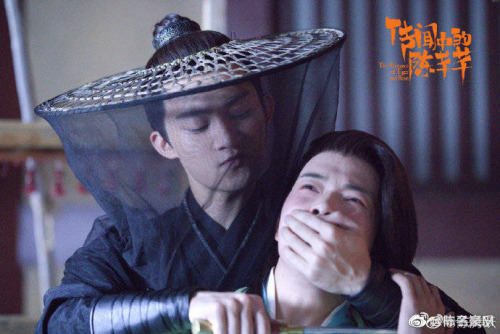
Later, as Tingting commits fully to his quest for revenge we’ll see him in all Black along with 2nd Princess and HS when HS believes he’s betrayed by CQQ.
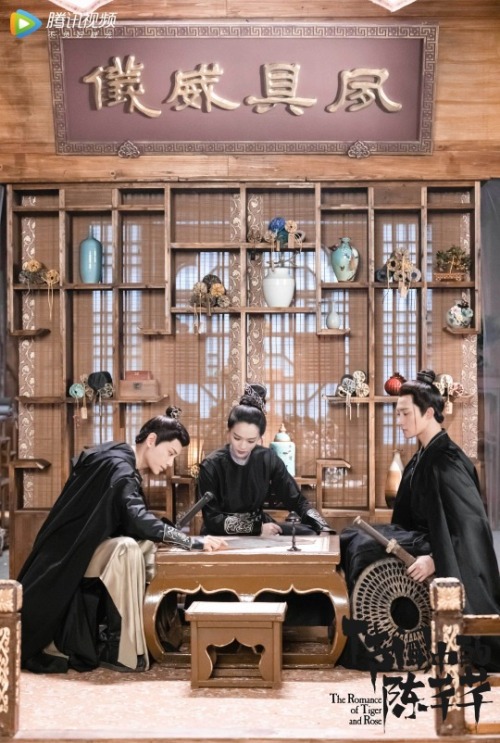

This is actually when I picked up on the color code. When HS is supporting 2nd Princess, he’s wearing all Black. No white at all. He retains some of the gold that’s a nod to his own royal heritage, but that’s it.
And the Black stays until he realizes CQQ still loves him.
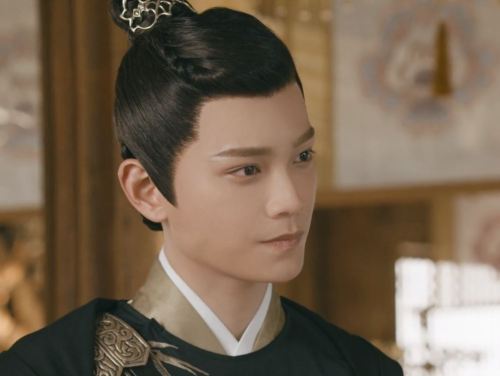
As soon as HS starts to soften to CQQ again we see the hint of a White collar under his armor (this is from his confrontation with the Queen).

At this point BJ is in full black and CQQ is wearing the palest of pinks, almost pure white. She’s lost all her confidence, broken her own heart trying to keep HS safe and letting him believe she hates him, and she’s mirroring his clothes when he came as a captive to the city.
By the next scene with 2nd Princess HS is softening and already his colors have changed again. Mostly white, reflecting his affection for CQQ but over his heart and framing him are the colors of 2nd Princess

HS is mostly himself here, or at least he’s closer to being his old self that he was before he fell in love with CQQ.
What’s beautifully done with this costume choice is the one touch of color is the orange on the bird.

And where do we see it again?
On CQQ’s robe when HS rushes to check on her after hearing she’s injured. After the betrayal and upheaval and everything they’ve gone to they are back to wearing the same color and finally coming back together.

Oranges and golds are good colors for our OTP in script world. It’s a direct call back to what they wore the first time they actually spent a passionate night together as a couple.

There’s excellent foreshadowing in this scene as Zi Rui, in disruptive black, comes to interrupt them. you can also see HS’s black belt is taking up a lot of his visual room. He’s matching CQQ but not completely. In terms of using costumes to foreshadow things, this is very well done.

You see the side characters allegiances change with their costumes. Most notably in Su Mu, the musician who originally wore softer pinks and oranges similar to CQQ and who switches to blue as he tries to distance himself from 1st Princess and the original script.

This is CQQ (red and wild) confronting Pei Heng and Lin Qi when Su Mu is fully on her side and fully at the mercy of others. He’s wearing all white.

Later we see Su Mu in the blue, 1st Princess wearing gold and orange (showing sympathy for CQQ), and 2nd Princess in her blue and black with a touch of white on her belt and collar signifying her slight sympathy/forgiveness of CQQ.

If you look at the cast wrap photos you can tell who is on which side by a glance at their costumes. This is really a good snap shot.
This is what you want to see in costume design. You want the costumes to reflect the story. There’s a lot of storytelling you can do by having characters wearing matching clothes, or choosing to wear a certain color in a significant area for the culture (the heart, the head, the feet, ect). I didn’t expect this level of costume commentary from what is, really, a romcom idol drama that is meant to be cute and fluffy.
It looks like a silly costume drama. It’s certainly being marketed as silly. But the meta in the writing, and the juxtaposition of choices between what you thought would happen and what should happen, the layers of complexity that exist in characters, and the costume storytelling are all A+ and make this one of my favorite Chinese dramas.
And, of course, it all plays into the final scene (which has stills and GIFs up because it’s aired in countries where I don’t live).

Back in the real world the script writer has fully embraced her red side. She’s in love. She’s willing to take chances. And there’s the antagonistic actor whose black uniform is now softened to gray with white lines on the wrist and collar. It’s a nice call back to his original prison uniform (after the dragon bone goes missing) and the first time HS committed to caring for CQQ.


